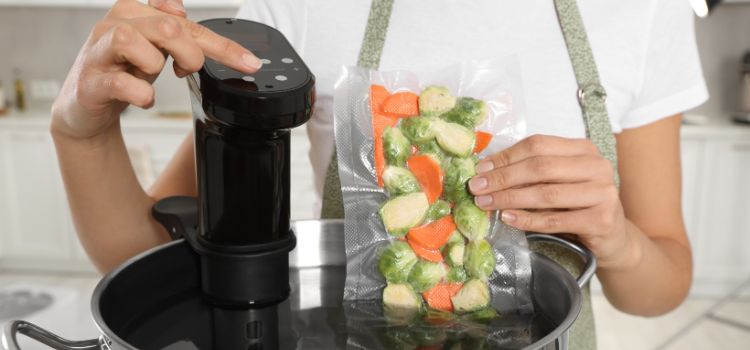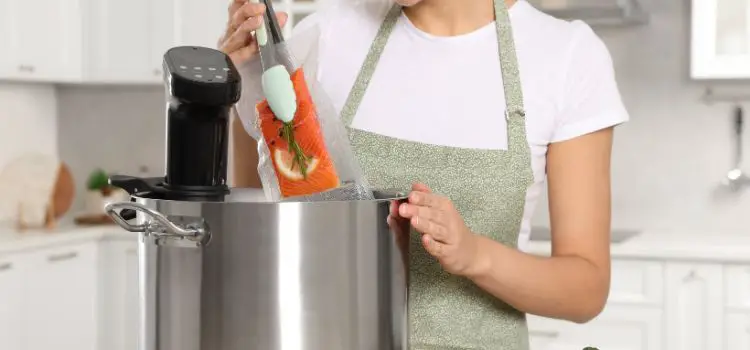As an Amazon Associate, I earn from qualifying purchases

Sous vide cooking has revolutionized the way we think about preparing meals. This method, which involves cooking food submerged in a precisely controlled water bath, allows for remarkable accuracy and consistency that traditional cooking methods often struggle to achieve. The appeal of sous vide lies in its ability to deliver perfect results every time, whether you’re cooking a tender steak or delicate piece of fish.
As this technique becomes more popular, many home cooks are looking for ways to streamline the process even further. One such consideration is using the original packaging that meat comes in for sous vide cooking. The idea of eliminating an extra step and cooking meat directly in its store-bought packaging is undeniably tempting. However, this convenience comes with its own set of questions regarding safety and effectiveness.
Types of Packaging Used for Meat
To understand whether sous vide in original packaging is feasible, it’s important to first look at the types of packaging commonly used for meat.
- Shrink Wraps: This packaging is typically used for meats that require a tight seal to prevent exposure to air. Shrink wraps are generally heat-sealed and form a tight fit around the meat. While these wraps are effective for preservation, they are not necessarily designed to withstand high temperatures.
- Vacuum-Sealed Bags: Often used for meats like steaks and roasts, vacuum-sealed bags remove air from the packaging, which helps in extending shelf life. These bags are made from various plastics, and their suitability for sous vide depends on whether they can handle prolonged exposure to heat.
- Plastic Trays: Commonly associated with ground meat and poultry, these trays are usually covered with a plastic film. The trays are sturdy enough for transportation and display but are typically not heat-resistant.
Each of these packaging types serves a purpose in preserving and displaying meat but varies significantly in terms of their ability to handle the heat involved in sous vide cooking.
Safety and Health Considerations
One of the primary concerns with using original packaging for sous vide cooking is the risk of chemical leaching. Many packaging materials contain chemicals like phthalates and bisphenol A (BPA), which can seep into food when heated. This is particularly concerning when the packaging is not designed to withstand cooking temperatures, as these chemicals can pose health risks.
Regulatory bodies like the Food and Drug Administration (FDA) have established guidelines for materials that are safe for food contact. These guidelines specify acceptable levels of chemical migration into food at certain temperatures. However, not all original meat packaging meets these standards for cooking conditions, which are often much higher than those for storage and display.
In addition to chemical concerns, original packaging might fail structurally under the prolonged heat of sous vide cooking. This could lead to leaks or contamination, compromising the quality and safety of the meat.
Tips for Assessing Packaging Suitability

If you’re considering using the original packaging for sous vide, it’s important to assess its suitability carefully.
- Check for Manufacturer Labels: Look for any labels or symbols on the packaging that indicate it is heat-resistant. Some packaging will include temperature thresholds or a microwave-safe label, which can be a good indicator of heat tolerance.
- Perform a Water Test: Before committing to using the packaging in sous vide, test its durability by submerging it in hot water. This can help you determine whether the material can withstand the cooking process without degrading or leaching chemicals.
These steps can provide some assurance, but they are not foolproof. The safest approach is to use packaging specifically designed for sous vide cooking.
Alternative Packaging Options
For those looking to eliminate uncertainty and ensure safety, using alternative packaging is a reliable option.
- Sous Vide-Specific Bags: These bags are manufactured to endure the high temperatures of sous vide cooking. Made from food-safe, BPA-free materials, they are designed to maintain their integrity and prevent chemical leaching, ensuring that your food remains uncontaminated.
- Reusable Silicone Bags: An environmentally friendly option, silicone bags offer durability and can be used multiple times. They provide a strong seal and are excellent at containing flavors and juices during cooking.
Both options are designed to work with sous vide machines and offer peace of mind that the cooking process will be both safe and effective.
Conclusion
While the convenience of cooking meat in its original packaging may be appealing, the potential risks associated with chemical leaching and packaging failure make it a less advisable option. By understanding the limitations of typical meat packaging and opting for alternatives specifically designed for sous vide cooking, you can enjoy all the benefits of this method without compromising safety.
As you explore sous vide cooking, consider experimenting with these recommended solutions to enhance your culinary repertoire. Engaging with online communities and resources can further expand your knowledge and provide valuable insights into the world of sous vide cooking.
FAQ
Can I sous vide meat in the store packaging?
It’s generally not recommended to sous vide meat in store packaging unless it’s specifically labeled as heat-safe. Most packaging isn’t designed to withstand sous vide temperatures and may release harmful chemicals. For safety, transfer meat to sous vide-compatible bags before cooking.
Can you sous vide chicken in the bag it comes in?
Sousing chicken in its original bag is risky unless the packaging is clearly marked as heat-resistant. Most store packaging can’t handle sous vide temperatures safely and might leach chemicals. It’s best to transfer chicken to sous vide-specific bags for optimal safety and results.
Can I sous vide in a plastic bag?
Yes, you can sous vide in a plastic bag, but it must be food-safe and heat-resistant. Sous vide-specific bags are designed for this purpose, ensuring no chemical leaching occurs. Avoid using regular plastic bags not intended for high temperatures to maintain safety and food quality.
As an Amazon Associate, I earn from qualifying purchases